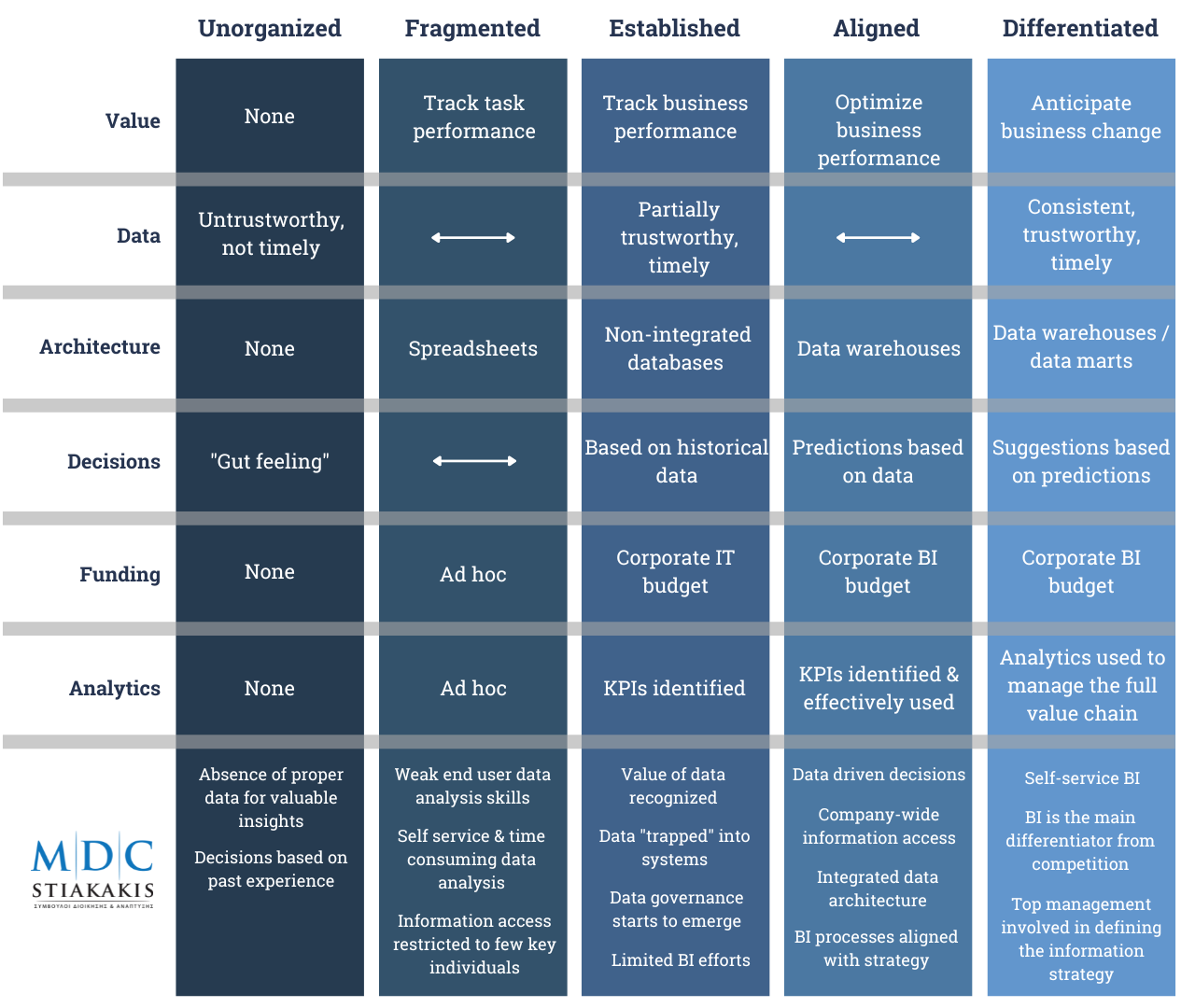Business Intelligence Maturity Model. What stage are you at?

What is Business Intelligence (BI)?
The concept of intelligence goes back to the Latin verb intellegere, meaning the ability to acquire, store, process information and transform them into new knowledge.
The above definition is the original meaning of intelligence. What does it have to do with Business Intelligence? The answer is that when we refer to a business, it indicates the exact same ability.
BI is seen by most as a software that analyzes data and produces managerial reports. But in reality, this is a very limited understanding of what BI does and one of the main reasons that many businesses ultimately fail to implement it properly.
The acquisition of technology does not necessarily mean acquisition of information. There are businesses with state-of-the-art technology but no information to make decisions. A BI system must be based on the corporate strategy, the processes, and the people involved, while data and software come at the end just to support the aforementioned.
What is the BI Maturity Model?
BI is not a skill that either exists or not. It is not an on/off feature. No business can go from information absence directly to making predictions. Like every characteristic that gives a competitive advantage, there is a path in between that must be followed.
The role of the BI maturity model is to map this path and provide guidance to any business that derives or wants to derive value from its data. It helps at assessing the current state of BI, but also to determine what future actions are required to move to the next level.
The BI Maturity Model of MDC Stiakakis
This model has 5 levels and was created based on our practical experience from businesses that we partnered in order to implement a BI system. These levels are not distinct, as it is very common, for a business in transition, to have characteristics from 2 adjacent levels.
 Level 1 – Unorganized
Level 1 – Unorganized
The key characteristic of this level is the lack of information due to the lack of data. Even if there are data in place, they cannot be used because they are available only to specific people. Decision making involve only the factor of experience, increasing the risk of wrong moves and/or inaction.
Level 2 – Fragmented
No organized efforts for data collection or analysis. Data are scattered within the company into different storages and spreadsheets. Time-consuming ad-hoc analysis efforts made by individuals, who usually spend their valuable productive time on excel spreadsheets (managers, department managers, salespeople etc.).
Level 3 – Established
The main activity of this level involves data collection, while analysis is premature and secondary activity. The first analytics efforts have begun, and deficiencies are being identified. Data governance (organization and technology) is at an early level, which does not yet allow integrated information.
Level 4 – Aligned
At this level the value provided by BI is aligned with the strategy and goals of the business. Procedures exist for data collection and analysis. The reliability, volume and type of data enable predictive analytics which are not yet integrated into day-to-day activities. Decisions are data driven.
Level 5 – Differentiated
At this level any business derives the maximum value from its BI system. Everyone in the business understands the value of data and every decision is made with information from its internal and external environment. Results from predictive models have been incorporated into day-to-day processes, enabling the ability of timely corrective actions.
3 Actions for climbing the BI "ladder"
Hire a BI consultant
If you don't know where to start, it is the ideal solution. A qualified BI consultant can guide you to align the BI system to your business strategy. She will examine parameters such as the business industry, the size of the company, its internal organization, its technology, etc. to prioritize actions, without suggesting any unnecessary ones.
Create a virtual BI team
A BI system does not necessarily means hiring new people and creating a separate department for this purpose. The ideal BI team consists of people who already work in different departments in the business. No one knows better the needs, and with the adequate support from the management, this approach is a great start. Of course, technological knowledge is also needed to translate needs into systems, however this could well be the job an external partner/consultant who will collaborate and guide the team.
Define basic data governance procedures
Data governance is a key activity that helps a business climb up levels in the model. It's about what data are needed, whether they exist, and whether they are clean, secure and organized to be analyzed. Data governance starts from the day-to-day processes of collection, the awareness of those involved with data to ensure integrity and ends with storage and security. Data management processes should be created from the moment a business acquires data (usually from the beginning), as otherwise the business risks having useless historical data.
MDC Stiakakis service
There is no shortage of data on the market today, and using them is not an option but a strategic decision. Our goal is not just to gather data, but to provide solutions that will give more knowledge to the right people at the right time. For this reason, we designed an innovative service ideal for:
-
Businesses that want to leverage their data in decision-making.
-
Businesses with old IT systems that do not provide insights.
-
Businesses that want to automate the time-consuming process of analyzing spreadsheets.
-
Businesses that need to monitor and keep track goals.
-
Businesses that want their people to have direct access to information their job (eg production managers, sellers, supplies, etc.).
-
Businesses with many different information systems that want to consolidate their data and have comprehensive insights.
-
Businesses that want to be informed on time about specific critical processes.
-
Groups of companies that need consolidated and automated information about every company in the group.
Find here case studies from various business sectors
| This article intends to inform the reader and in no way substitutes the specialized consulting services. For more information, please contact MDC Stiakakis SA (Monis Kardiotisis 49, Heraklion | +30 2810 280985) |


